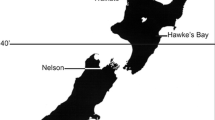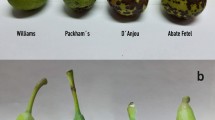Abstract
Xanthomonas campestris pv. vesicatoria, the causal agent of bacterial scab of pepper, was isolated in several regions in Israel. When artificial inoculation was practiced, pathogen growth was enhanced by high temperatures (30-36°C), and an inoculum concentration of 10p6 colony-forming units (CFU) per ml was optimal for symptoms to develop on plants. Pre-inoculation treatments such as wounding the leaves by rubbing them with carborundum powder or spraying them with diluted wax solvents, markedly increased disease severity, but were not essential. Pre-inoculation conditioning at two different relative humidity levels (R.H. = 100% or R.H. < 40%) did not affect disease severity. Young leaves were more severely affected following infection than older leaves. Disease severity was similar with several isolates ofX. campestris pv. vesicatoria.
Similar content being viewed by others
References
Bashan, Y., Diab, S. and Okon, Y. (1982) Survival ofXanthomonas campestris pv.vesicatoria in pepper seeds and roots, in symptomless and dry leaves in nonhost plants and in the soil.Pl. Soil 64 (in press).
Bashan, Y., Okon, Y. and Henis, Y. (1978) Infection studies ofPseudomonas tomato, causal agent of bacterial speck of tomato.Phytoparasitica 6: 135–143.
Devash, Y., Okon, Y. and Henis, Y. (1980) Survival ofPseudomonas tomato in soil and seeds.Phytopath. Z. 99: 175–185.
Doidge, Z.M. (1921) A tomato canker.Ann. appl. Biol. 7: 407–430.
Gardner, M.W., andKendrick, J.B.(1921) Bacterialspotoftomato.J. agnic. Res. 21: 123–156.
Henis, Y., Okon, Y., Sharon, E. and Bashan, Y. (1980) Detection of small numbers of phytopathogenic bacteria using the host as an enrichment medium.J. appl. Bact. 49: vi (abstr.).
Leben, C. (1963) Multiplication ofXanthomonas vesicatoria on tomato seedlings.Phytopathology 53: 778–781.
Leben, C., Daft, G.C. and Schmitthenner, A.F. (1968) Bacterial blight of soybeans: Population levels ofPseudomonas glycinea in relation to symptom development.Phytopathology 58: 1143–1146.
Morton, D.J. (1966) Bacterial spot development in excised pepper and tomato leaves at several temperatures.Phytopathology 56: 1194–1195.
Nayudu, M.V. and Walker, J.C. (1960) Bacterial spot of tomato as influenced by temperature and by the age and nutrition of the host.Phytopathology 50: 360–364.
Okon, Y., Bashan, Y. and Henis, Y. (1978) Studies of bacterial speck of tomato caused byPseudomonas tomato. Proc. 4th Int. Conf. Pl. Path. Bact. (Angers) pp. 699–702.
Peterson, G.H. (1963) Survival ofXanthomonas vesicatoria in soil and diseased tomato plants.Phytopathology 53: 765–767.
Schnathorst, W.C. (1966) Unaltered specificity in several Xanthomonads after repeated passage throughPhaseolus vulgaris.Phytopathology 56: 58–60.
Sharon, E., Okon, Y., Bashan, Y. and Henis, Y. (1981) Leaf enrichment: a method for detecting small numbers of phytopathogenic bacteria in seeds and symptomless leaves of vegetables.Phytoparasitica 9: 250 (abstr.).
Shaw, L. (1935) Intercellular humidity in relation to fire-blight susceptibility in apple and pear.Mem. Cornell Agric. Exp. Stn 181: 3–40.
Shekhawat, P.S. and Chakravarti, B.P. (1976) Factors affecting development of bacterial leaf spot of chillies caused byXanthomonas vesicatoria.Indian Phytopath. 29: 393–402.
Vakili, N.G. (1967) Importance of wounds in bacterial spot (Xanthomonas vesicatoria) of tomatoes in the field.Phytopathology 57: 1099–1103.
Volcani, Z. (1962) Bacterial spot disease of tomatoes and peppers in Israel.Pl. Dis. Reptr 46: 175.
Yunis, H., Bashan, Y., Okon, Y. and Henis, Y. (1980) Two sources of resistance to bacterial speck of tomato caused byPseudomonas tomato.Pl. Dis. 64: 851–852.
Author information
Authors and Affiliations
Rights and permissions
About this article
Cite this article
Diab, S., Bashan, Y. & Okon, Y. Studies of infection withxanthomonas campestris pv.vesicatoria, causal agent of bacterial scab of pepper in Israel. Phytoparasitica 10, 183–191 (1982). https://doi.org/10.1007/BF02994527
Received:
Issue Date:
DOI: https://doi.org/10.1007/BF02994527




